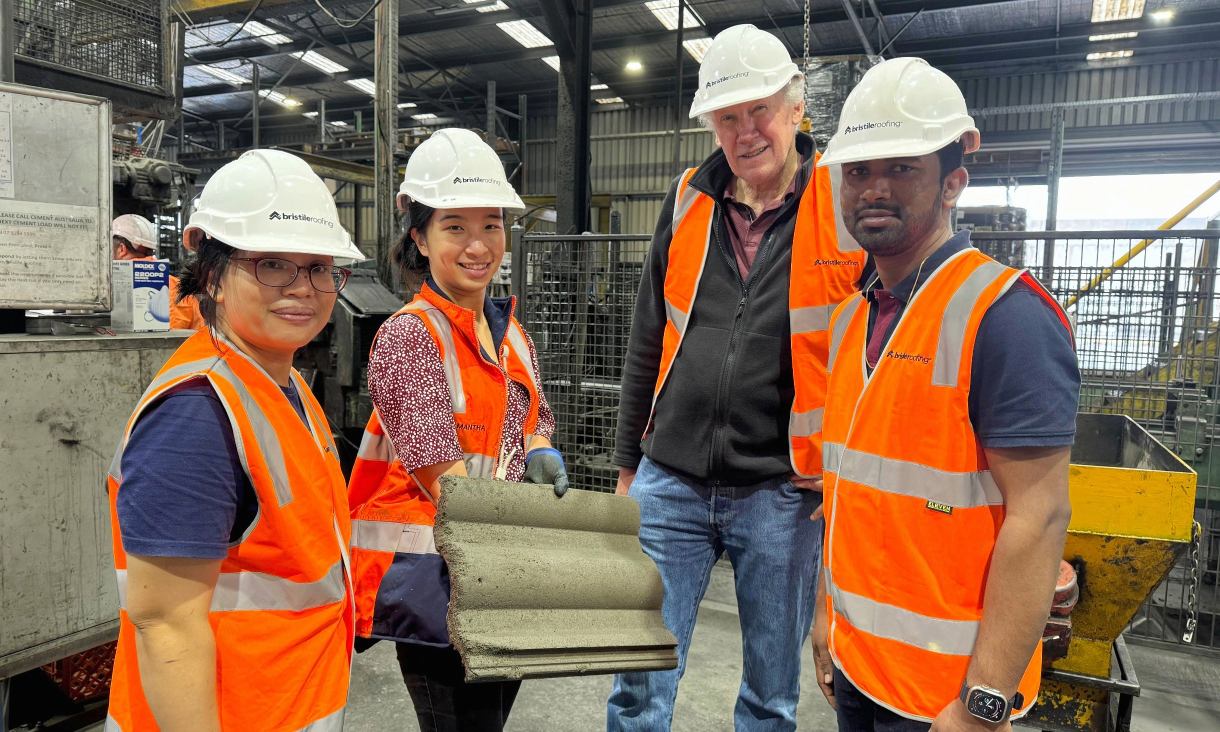Low Carbon Roof Tiles Give Industrial Waste New Home – Mirage News

Report on the Development of Low-Carbon Construction Materials from Industrial Waste
1.0 Introduction
A collaborative project between RMIT University and Bristile Roofing has successfully trialed the large-scale production of sustainable concrete roof tiles. This initiative directly addresses several Sustainable Development Goals (SDGs) by transforming industrial waste streams, specifically coal ash and recycled glass, into viable, low-carbon construction materials. The project demonstrates a significant advancement in creating a circular economy within the construction industry, aligning with global sustainability targets.
2.0 Project Findings: Sustainable Roof Tiles
Full-scale manufacturing trials have yielded concrete roof tiles with a reduced environmental footprint and enhanced engineering properties. The findings are critical for advancing sustainable infrastructure and production patterns.
2.1 Material Composition and Waste Valorization
- Virgin Material Replacement: A total of 20% of virgin materials were replaced with industrial waste.
- Cement Substitution: 10% of cement was replaced with harvested pond ash from coal-fired power stations.
- Sand Substitution: 10% of river sand was replaced with unwashed recycled glass sand.
2.2 Performance and Environmental Impact
- Carbon Footprint Reduction: A comprehensive life cycle assessment confirmed a 13% reduction in CO₂ emissions compared to conventional concrete tiles, directly contributing to SDG 13 (Climate Action).
- Enhanced Properties: The resulting tiles are lighter and exhibit superior fire resistance, a crucial feature for climate-resilient infrastructure under SDG 9 and SDG 11.
- Standards Compliance: The products successfully meet Australian Standards for strength and durability, ensuring their viability for commercial application.
3.0 Alignment with Sustainable Development Goals (SDGs)
This research makes substantial contributions to the UN Sustainable Development Goals through innovative industrial processes and responsible resource management.
- SDG 12: Responsible Consumption and Production: The project epitomizes circular economy principles by diverting significant waste streams from landfills. It addresses Australia’s annual generation of 12 million tonnes of coal ash and 1.3 million tonnes of glass waste, transforming them into high-value products.
- SDG 9: Industry, Innovation, and Infrastructure: The initiative showcases innovation in manufacturing and develops resilient, sustainable building materials that enhance infrastructure quality.
- SDG 11: Sustainable Cities and Communities: By creating greener construction materials, the project supports the development of sustainable and resilient urban environments.
- SDG 13: Climate Action: The quantifiable reduction in CO₂ emissions demonstrates a direct contribution to mitigating climate change through greener industrial practices.
4.0 Broader Applications and Future Outlook
4.1 Extension to Concrete Bricks
The core concrete mix design has been adapted to produce sustainable concrete bricks, further amplifying the project’s impact on SDG targets.
- Waste Material Content: The brick prototypes incorporate 35% waste materials (15% pond ash and 20% glass sand).
- Environmental and Performance Gains:
- An 18% reduction in CO₂ emissions was demonstrated through a whole life cycle assessment.
- Thermal insulation is improved by 30%, reducing energy consumption in buildings.
- The bricks meet Australian standards for load-bearing structural concrete and fire performance.
4.2 Commercialization and Scalability
The project is transitioning from research to implementation. Key future steps include:
- Initiating real-world trials of the roof tiles in collaboration with local councils.
- Progressing to manufacturing trials for the concrete brick product with industry partners.
- Securing reliable local waste resources to ensure consistent quality and volume for scaled production.
The research is supported by the ARC TREMS Hub, which aims to transform reclaimed waste into engineered materials, reinforcing the national commitment to a circular economy and the Sustainable Development Goals.
1. Which SDGs are addressed or connected to the issues highlighted in the article?
SDG 9: Industry, Innovation and Infrastructure
- The article focuses on an innovative industrial process developed through a partnership between a university (RMIT) and a manufacturing company (Bristile Roofing). This collaboration aims to create sustainable infrastructure materials (roof tiles and bricks), directly aligning with the goal of building resilient infrastructure and fostering innovation.
SDG 11: Sustainable Cities and Communities
- The project addresses a key challenge for sustainable cities: waste management. By repurposing industrial by-products like coal ash and glass waste, it helps reduce the amount of material sent to landfills, thereby lessening the environmental impact of urban and industrial areas. The development of more fire-resistant building materials also contributes to making human settlements safer and more resilient.
SDG 12: Responsible Consumption and Production
- This goal is central to the article’s theme. The project promotes a circular economy model by transforming waste into valuable resources. It substantially reduces waste generation by recycling and reusing materials, and it encourages the efficient use of natural resources by replacing virgin materials (cement, river sand) with waste products, thus ensuring sustainable production patterns.
SDG 13: Climate Action
- The article explicitly states that the new manufacturing process leads to a significant reduction in carbon emissions. The life cycle assessment showed a “13% reduction in CO₂ emissions” for tiles and an “18% reduction in CO₂ emissions” for bricks. This directly contributes to mitigating climate change, which is the core objective of SDG 13.
2. What specific targets under those SDGs can be identified based on the article’s content?
SDG 9: Industry, Innovation and Infrastructure
- Target 9.4: “By 2030, upgrade infrastructure and retrofit industries to make them sustainable, with increased resource-use efficiency and greater adoption of clean and environmentally sound technologies and industrial processes…” The article describes the development and trial of a new, environmentally sound manufacturing process for roof tiles and bricks that uses waste materials, thereby increasing resource-use efficiency.
- Target 9.5: “Enhance scientific research, upgrade the technological capabilities of industrial sectors…” The project is a collaboration between RMIT University and Bristile Roofing, supported by the ARC Industrial Transformation Research Hub (TREMS). This exemplifies the enhancement of scientific research and its application to upgrade the technological capabilities of the construction materials industry.
SDG 11: Sustainable Cities and Communities
- Target 11.6: “By 2030, reduce the adverse per capita environmental impact of cities, including by paying special attention to air quality and municipal and other waste management.” The project directly addresses waste management by finding a productive use for “12 million tonnes of coal ash” produced annually and “over 1.3 million tonnes of glass waste,” much of which would otherwise end up in landfills.
SDG 12: Responsible Consumption and Production
- Target 12.2: “By 2030, achieve the sustainable management and efficient use of natural resources.” The project achieves this by replacing virgin materials like cement and river sand with waste products. The article specifies “a total of 20% virgin material replacement” for tiles and “35% waste materials” for bricks.
- Target 12.5: “By 2030, substantially reduce waste generation through prevention, reduction, recycling and reuse.” The entire initiative is based on recycling and reusing two major industrial waste streams (coal ash and glass), preventing them from being landfilled and thus substantially reducing waste generation.
SDG 13: Climate Action
- Target 13.2: “Integrate climate change measures into national policies, strategies and planning.” While not discussing policy directly, the project represents a tangible measure that contributes to climate change mitigation. The documented reduction in CO₂ emissions is a practical step that aligns with the goals of climate action strategies.
3. Are there any indicators mentioned or implied in the article that can be used to measure progress towards the identified targets?
-
Reduction in CO₂ Emissions
The article provides precise quantitative data on the reduction of greenhouse gas emissions, which is a direct indicator for climate action (SDG 13).
- Indicator: A “13% reduction in CO₂ emissions compared to conventional concrete tiles.”
- Indicator: An “18% reduction in CO₂ emissions” for concrete bricks made with waste materials.
-
Waste Material Utilization Rate
The percentage of waste material incorporated into the new products serves as a clear indicator for waste reduction and resource efficiency (SDG 11.6, SDG 12.2, SDG 12.5).
- Indicator: “replacing 10% of cement with harvested pond ash and 10% of river sand with unwashed glass waste – a total of 20% virgin material replacement” in roof tiles.
- Indicator: Concrete bricks using “15% harvested pond ash and 20% unwashed glass sand – totalling 35% waste materials.”
-
Volume of Waste Diverted from Landfill
The article implies an indicator related to the total amount of waste that can be repurposed. Progress can be measured by the tonnage of coal ash and glass waste used in production instead of being sent to landfill (SDG 11.6, SDG 12.5).
- Indicator: The project addresses the “12 million tonnes of coal ash” and “1.3 million tonnes of glass waste” generated annually in Australia. The amount of this waste used in manufacturing would be the measure.
-
Product Performance and Compliance
The engineering performance of the final product is an indicator of successful innovation (SDG 9.5).
- Indicator: The new tiles and bricks meet “Australian Standards for strength and durability” and “fire performance.”
- Indicator: The bricks demonstrate improved insulation, “reducing heat loss by 30% compared to conventional cement bricks.”
4. Summary Table of SDGs, Targets, and Indicators
| SDGs | Targets | Indicators |
|---|---|---|
| SDG 9: Industry, Innovation and Infrastructure |
9.4: Upgrade industries to make them sustainable and increase resource-use efficiency.
9.5: Enhance scientific research and upgrade technological capabilities. |
– Percentage of waste materials used in production (20% for tiles, 35% for bricks). – Meeting Australian Standards for strength, durability, and fire resistance. – Collaboration between university (RMIT) and industry (Bristile Roofing). |
| SDG 11: Sustainable Cities and Communities | 11.6: Reduce the adverse per capita environmental impact of cities, focusing on waste management. |
– Volume of coal ash and glass waste diverted from landfills. – Development of fire-resistant building materials for safer settlements. |
| SDG 12: Responsible Consumption and Production |
12.2: Achieve sustainable management and efficient use of natural resources.
12.5: Substantially reduce waste generation through recycling and reuse. |
– Percentage of virgin material (cement, river sand) replaced by waste. – Total tonnage of industrial waste (coal ash, glass) recycled into new products. |
| SDG 13: Climate Action | 13.2: Integrate climate change measures into policies and planning. |
– Percentage reduction in CO₂ emissions (13% for tiles, 18% for bricks). – Improved insulation properties of bricks (30% reduction in heat loss). |
Source: miragenews.com
What is Your Reaction?
 Like
0
Like
0
 Dislike
0
Dislike
0
 Love
0
Love
0
 Funny
0
Funny
0
 Angry
0
Angry
0
 Sad
0
Sad
0
 Wow
0
Wow
0
















































:focal(1500,1000)/https://media.globalcitizen.org/a6/9a/a69a4720-d8a1-4715-b596-18738d03c05c/rotary_polio_hero_image.jpg?#)







/countries/sri-lanka/photo-credit---dmc-sri-lanka.tmb-1200v.jpg?sfvrsn=dc298bcc_1#)


















